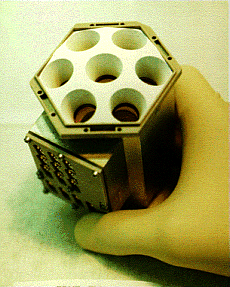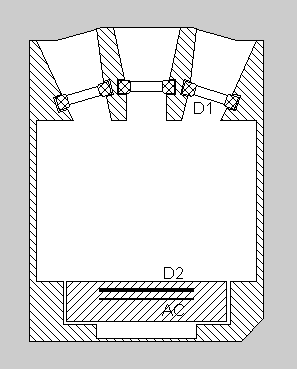|
 Measurement of energy spectra of low-energy particles is carried out by the Low
Energy Detector. Particles from protons up to iron in the energy range of 1.3-
13 MeV (protons) and isotopes up to neon can be resolved.
LED consists of detector layers D1, D2, and AC with pulse amplification and
digitisation electronics. The uppermost detector layer, D1, is composed of seven
circular detectors D11-D17 in order to have a large geometrical factor and, at the same
time to minimise the path length variation of incident particles in the detector layer,
thus maintaining a good mass resolution. D11 and D16 are surface barrier detectors
with a nominal thickness of 20 mm. The other D1i's are 80 mm thick ion implanted
detectors. The thickness of the ion implanted surface passivated D2 detector is 1000
mm. Each of the D1 detectors operates in coincidence with D2 and in anticoincidence
with AC. The geometrical factor of the telescope D11-D2 is
0.135 cm2 · sr and
0.130 cm2 · sr
for each of the other telescopes D1i-D2 (i=2,7).
Measurement of energy spectra of low-energy particles is carried out by the Low
Energy Detector. Particles from protons up to iron in the energy range of 1.3-
13 MeV (protons) and isotopes up to neon can be resolved.
LED consists of detector layers D1, D2, and AC with pulse amplification and
digitisation electronics. The uppermost detector layer, D1, is composed of seven
circular detectors D11-D17 in order to have a large geometrical factor and, at the same
time to minimise the path length variation of incident particles in the detector layer,
thus maintaining a good mass resolution. D11 and D16 are surface barrier detectors
with a nominal thickness of 20 mm. The other D1i's are 80 mm thick ion implanted
detectors. The thickness of the ion implanted surface passivated D2 detector is 1000
mm. Each of the D1 detectors operates in coincidence with D2 and in anticoincidence
with AC. The geometrical factor of the telescope D11-D2 is
0.135 cm2 · sr and
0.130 cm2 · sr
for each of the other telescopes D1i-D2 (i=2,7).
 The combination of the two thin D1 detector telescopes, D11-D2 & D12-
D2 is referred as LED I and the combination of the five thick D1
detectors is referred as LED II. A thin foil (1 mg/cm2) shields
the outer silicon
detectors. The geometrical factor of LED I is
0.27 cm2 · sr
and that of LED II
0.65 cm2 · sr
.
The combination of the two thin D1 detector telescopes, D11-D2 & D12-
D2 is referred as LED I and the combination of the five thick D1
detectors is referred as LED II. A thin foil (1 mg/cm2) shields
the outer silicon
detectors. The geometrical factor of LED I is
0.27 cm2 · sr
and that of LED II
0.65 cm2 · sr
.
In order to decrease the path length variation in D1i layers due to variation
in zenith angle these detectors are tilted with respect to D2 and a collimator
ring of radius of 9.5 mm is mounted at a height of 21 mm above each D1i. The
collimators are integrated into one structure made of white-painted
aluminium.
In addition to the anticoincidence an event can be rejected also by the on-board
analysis program if the ratio of energy deposited in thin D1 vs. D2 is too low to enable
the required resolution; In other words: the two thin D1i windows are used at the
lowest energies only.
LED Operational Characteristics:
Field of View: 32 degrees, circular
Energy Range:
Proton and helium: 1.3-13 MeV/n
Other nuclei: 2.4-50 MeV/n
Geometrical Factor: 0.26 cm2 · sr (LED I)
and 0.64 cm2 · sr (LED II)
Temporal Resolution: 60 seconds, protons 10 seconds
|
|

